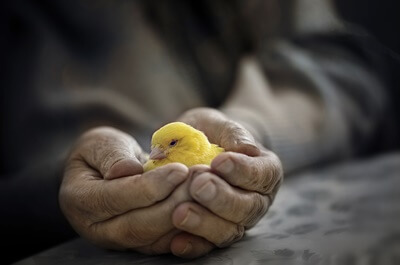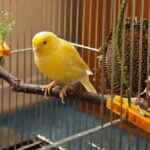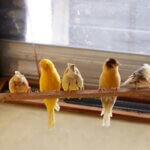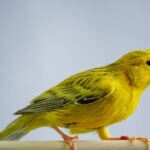Canaries don’t enjoy excessive handling and are best admired from their cages.
However, that doesn’t mean you should never touch canaries. With hand-taming, canaries enjoy perching and hand-feeding; some even allow you to pet their heads and chests.
The key is to form a strong bond with your canary and show it that your hand and your touch are safe. With hand-taming sessions and treats, you can help a canary learn that it’s rewarding to be held.
Can Canaries Be Handled?
Despite being friendly birds, canaries aren’t overly social. They live well as the only bird in their cage and enjoy their privacy, opting to be left alone most of the time.
This is why most people assume that pet canaries should never be handled.
In truth, canaries require less handling than larger, more social birds, but that doesn’t mean they’re incapable of forming strong bonds with their owners or enjoying their attention.
Canaries don’t want to be cuddled, wrapped in a blanket, or have their wings restricted by human hands. Instead, good canary handling may include the following:
- Perching on your finger or shoulder
- Being pet on the head or across the chest
- Hand-feeding
These handling methods don’t restrict the canary’s ability to back away or fly off if it feels unsafe.
It still requires trust but doesn’t make the canary feel vulnerable, unlike being held in your palm with its wings restricted and feet unable to grip for stability.
When Do Canaries Not Like Being Held?
Pet canaries enjoy or tolerate being handled to an extent. However, certain factors will trigger a canary’s aversion to being touched or handled in any way by its owners, including:
New Canary
As prey animals, canaries remain on high alert for any environmental threats.
Consequently, when they’re put in an unfamiliar environment with strangers, they often become anxious and panicky. They’ll react excessively to perceived dangers, such as when picked up or handled.
When bringing a new canary home, touch it minimally. Set up its cage in a quiet room away from loud noises, other pets, and anything else that might cause your pet to become agitated. This will help it settle in sooner and feel comfortable enough to accept that your hand and its touch are safe.
Molting
According to Development of the Nervous System, canaries molt primarily during summer.
Although molting is natural, it’s physically draining and uncomfortable. They’ll feel tired, itchy, and ill-tempered, which doesn’t lend itself to accepting an owner’s handling.
The emerging pin feathers may be so sensitive that they break or bend from handling, leading to pain, bleeding, and even infection for the canary.
Illness and Injuries
Canaries don’t cope well with illness and isolate themselves more when sick. This can keep them from predators or other birds that might harm them when feeling weak.
Even if you don’t plan on harming your canary, it’ll view any invasion of its space and all forced handling as a threat. This could stress it out, make the illness worse, and emotionally upset the canary.
The same applies to a canary that has been injured. Perhaps it fought with a cage mate or caught its feet or wings in a toy or the cage bars.
In this condition, it’ll prefer to isolate and heal and dislike being drawn out and held.
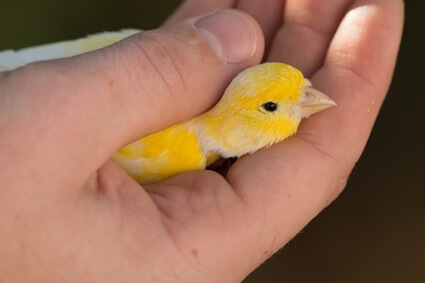
Unhappiness
A stressed canary will avoid handling, much like when sick. Unhappiness can be caused by the following:
- Poor nutrition
- Lack of exercise
- External and internal parasites
- Bullying by cage mates
If your canary is emotionally distressed, it’ll prefer to hunker down and wait for the upsetting factor to disappear. Handling it makes it exposed and vulnerable, and it’s likely to react with fear or aggression.
Therefore, if you notice signs of stress in your canary, determine its underlying reason and solve it as best you can. Intense symptoms of stress include:
- Biting
- Lots of noise
- Lunging
- Lack of appetite
- Feather-plucking
Are Canaries Easy To Tame?
Canaries are intelligent birds that are capable of learning new tricks and behaviors. Scientific American found that canaries possess impressive problem-solving skills.
That said, taming a canary is more challenging than taming other pet birds because canaries aren’t as intelligent as parrots, so they’ll need more repetition and patience to adapt to new behaviors.
They’ll be slower to learn training and may revert if left alone without your company for too long.
The highest chance of success in taming a canary happens before it fledges, usually at about 15 days of age. At this time, you can start hand-feeding your pet to get it accustomed to you.
The more it trusts and relies on you, the more receptive it’ll be to taming. It may even grow into the behaviors you want naturally instead of needing to adapt to them from previous habits.
Even if you’ve acquired a matured canary, it’s still possible to tame it, and it’ll merely take more time, dedication, and patience. Don’t expect results until several weeks or months of training, especially if your taming sessions are short or infrequent.
How Do You Tame A Canary?
A tame canary will be friendlier, more docile, and easier to handle. It may even prefer to sit on your finger or snuggle up against your neck when placed on your shoulder, and it’ll look forward to your company.
The taming process isn’t complicated, but it does require consistency. You must commit to several training sessions that often repeat the same steps. This makes it dull in some ways, but if you view it as a chance to bond with your canary, it can be rewarding.
Understand Your Canary’s Age And Personality
The age and personality of your canary determine how easy or difficult the taming process will be.
Ideally, your canary won’t have fully fledged, though any age younger than six months is still within the ideal range. If you have an older canary, you should expect the taming process to require more time.
Beyond that, consider its temperament levels. A canary with a curious and engaging personality will be more eager to learn and responsive to lessons.
However, a shy or apprehensive canary may back away if you approach it and struggle to focus on the lessons. The more relaxed the bird is around you in the beginning, the easier it’ll be to tame.
Even if your canary isn’t ideal for training, you can still overcome this with consistency, praise, and patience. All canaries can learn new things; some need more effort than others.
Introduce Yourself And Your Presence
If your canary is new to your home, give it time to get used to you before attempting to hand-tame it.
Start by speaking to it gently or singing and whistling near its cage. This will familiarize it with your voice and tone and teach it that you are interested in spending time with it.
If your canary is already established in your home, dedicate more time to socializing with it similarly. You need a solid foundation for training, and talking, singing, or spending time near the cage will help strengthen that foundation.
Hand-Train It
Handling requires the canary to trust your hand and see it as a non-threat.
You can help establish this trust by gently placing your hand inside the canary’s cage without invading its space or trying to grab the bird.
If you place a treat in your palm, this will help the canary see your hand as a source of good things, not immediate grabbing and restricting.
Be sure to speak throughout this in a calm, warm tone, so your canary understands you’re still the trusted person in the room.
Hand Feed Your Canary
Once the canary has adjusted to the presence of your hand, get in the habit of offering your canary food right from your hand daily. This may include placing seeds in your palm.
The more comfortable the bird gets with being near your hand and accepting what you offer with little hesitation, the more it will begin to trust you.
Start Petting
Hold a treat in the opening of your canary’s cage and beckon it to approach. Once your pet steps out of its cage, reward it with a treat.
Next, gently brush your finger across its chest or head, whichever the canary allows. It may back up or resist at first, and this is fine. Don’t force it to accept the petting.
Gradually upgrade to petting it more often and with more force, but not enough to set the canary off balance. This will teach it that handling isn’t bad.
Teach The Canary To Perch
Now that your canary is more accepting of your touch, repeat the process to draw it out of its cage and gently press your finger against its legs.
Offer a treat as you do this so the canary is tempted to go forward despite the prodding. It should step up onto your finger after a moment.
When it does, reward it with a treat and gentle praise. You should repeat this exercise once every day for at least 15 minutes.
Over time, your canary will learn to perch on your hand when you beckon to it, even in the absence of a treat. Then, you can introduce new tricks since it trusts you and will be more responsive.

